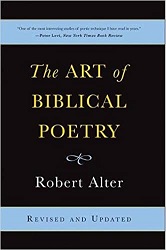by Robert Alter
Basic Books, Revised and Updated 2011. Original edition published in 1985. 296 pages.
Review written June 8, 2021, from my own copy
I purchased a copy of The Art of Biblical Poetry after reading the author’s book The Art of Bible Translation. That one was written for a more general audience and is about Bible translation in general, but it made me want more in-depth information. I’m writing a not very academic book about Psalms, so I wanted to know more about the original language.
I learned so much! I knew that biblical poetry has parallelism, but this book showed me nuances in that parallelism I hadn’t been aware of before. I also learned that there’s a rhythm to Hebrew poetry, a certain number of beats per line, which can’t always be translated well.
The author covers all different types of biblical poetry – and before reading, I hadn’t realized that different types even existed. The beginning looks more deeply at parallelism and has a whole chapter called “Structures of Intensification,” looking at how parallelism is used. He looks at sections of narrative poetry that tell a story, and then moves on to looking at the poetry in different books of the Bible – first Job, then Psalms, then the prophetic books, then Proverbs, and then Song of Songs. Finally, there’s a summary chapter.
In the summary chapter, he makes the case that the poetry in the Bible isn’t often studied as poetry.
The aim of my own inquiry has been not only to attempt to get a firmer grasp of biblical poetics but also to suggest an order of essential connection between poetic form and meaning that for the most part has been neglected by scholarship. For if I have used the image of brushing away deposits from a beautiful surface to describe the task at hand, I should add that poetry is quintessentially the mode of expression in which the surface is the depth, so that through careful scrutiny of the configurations of the surface – the articulation of the line, the movement from line to poem, the imagery, the arabesques of syntax and grammar, the design of the poem as a whole – we come to apprehend more fully the depth of the poem’s meaning.
The choice of the poetic medium for the Job poet, or for Isaiah, or for the psalmist, was not merely a matter of giving weight and verbal dignity to a preconceived message but of uncovering or discovering meanings through the resources of poetry. In manifold ways, some of which I try to illustrate here from chapter 4 onward, poetry is a special way of imagining the world or, to put this in more cognitive terms, a special mode of thinking with its own momentum and its own peculiar advantages.
Throughout the book, he looks at specific passages in depth, looking at those things he mentions – “the articulation of the line, the movement from line to poem, the imagery, the arabesques of syntax and grammar, the design of the poem as a whole.” This isn’t light reading, and it took me a long time to get through the whole book, but I did gain a new appreciation for these passages as works of poetry and a new appreciation for what was going on in the original language.
This is not light reading, and I don’t recommend it unless you’re ready for an intense academic work. But if you know what you’re getting into, this book is full of insights that will add to your appreciation and understanding of the Biblical text.
Find this review on Sonderbooks at: www.sonderbooks.com/Nonfiction/art_of_biblical_poetry.html
Disclosure: I am an Amazon Affiliate, and will earn a small percentage if you order a book on Amazon after clicking through from my site.
Disclaimer: I am a professional librarian, but the views expressed are solely my own, and in no way represent the official views of my employer or of any committee or group of which I am part.
What did you think of this book?
